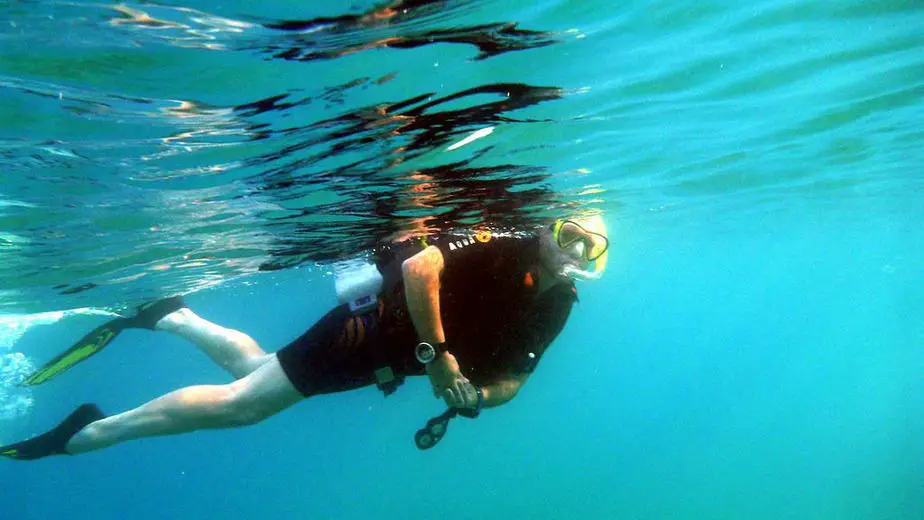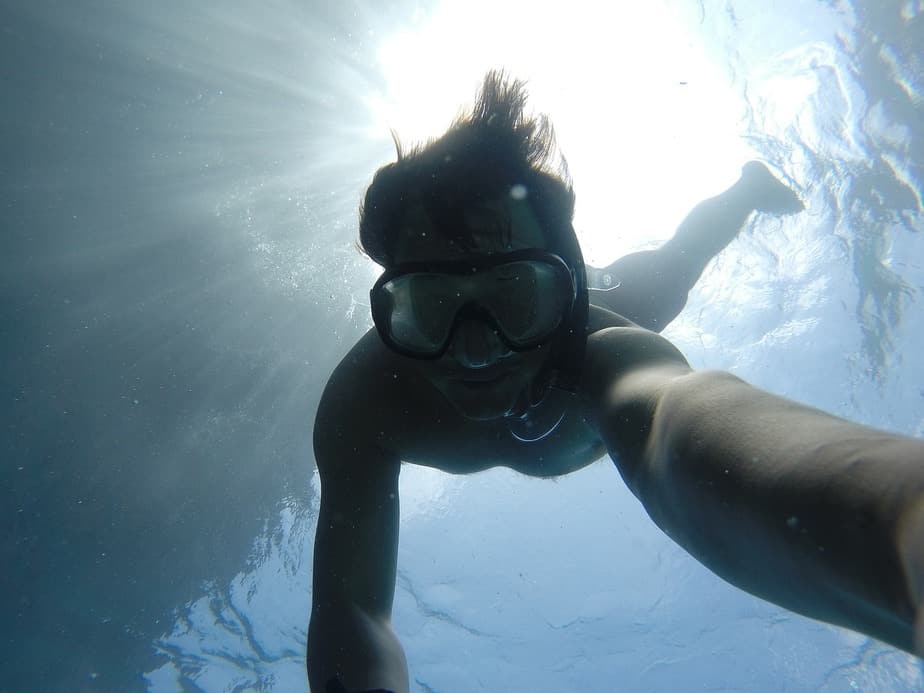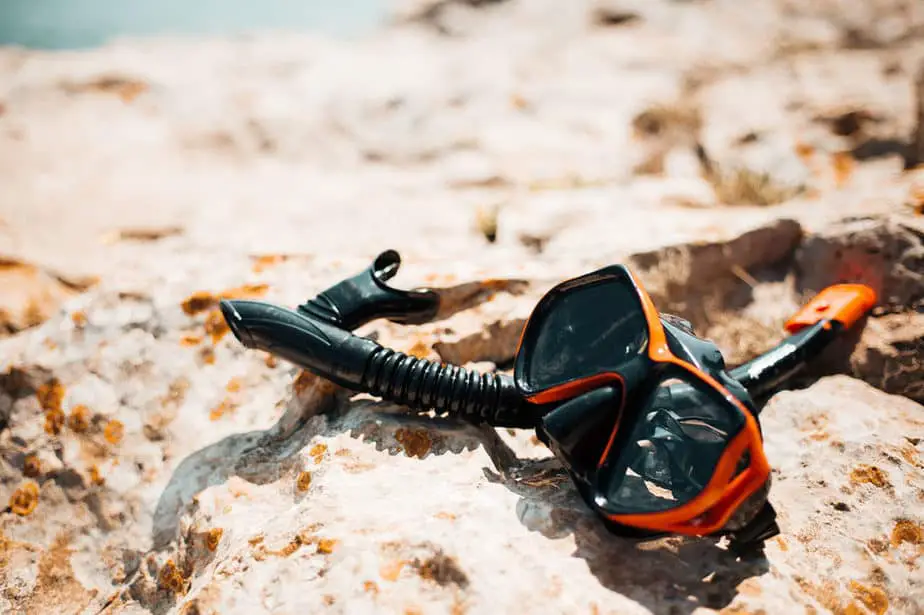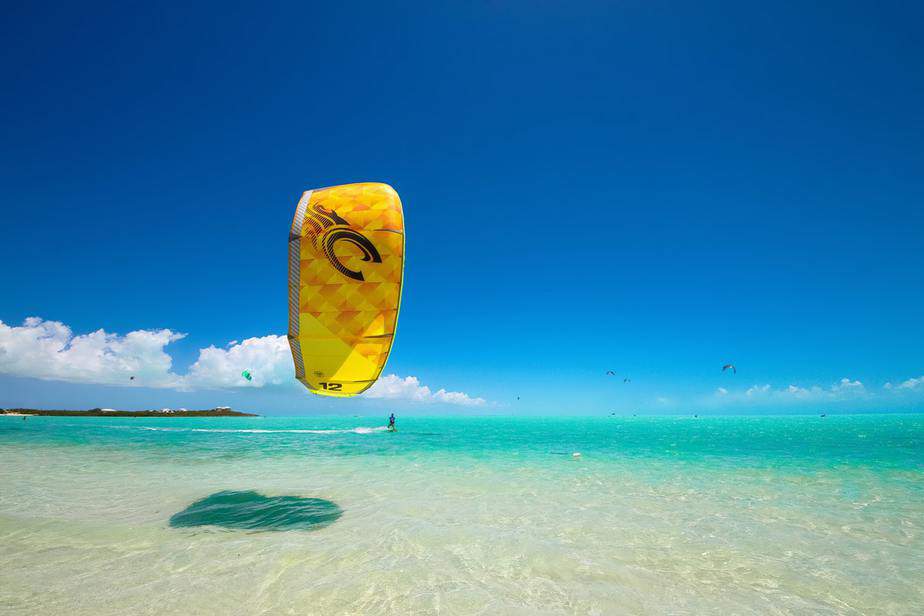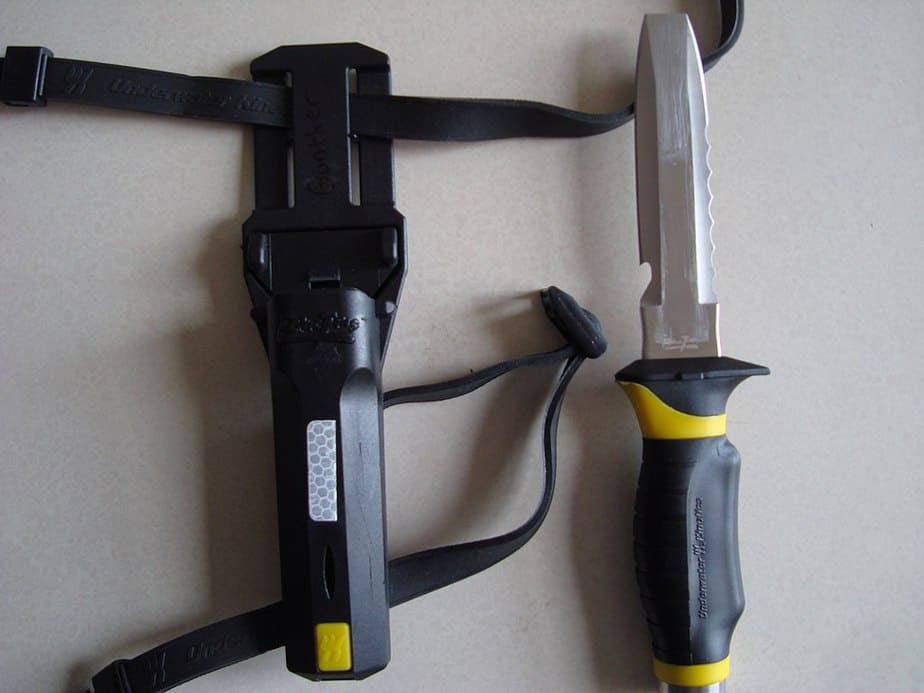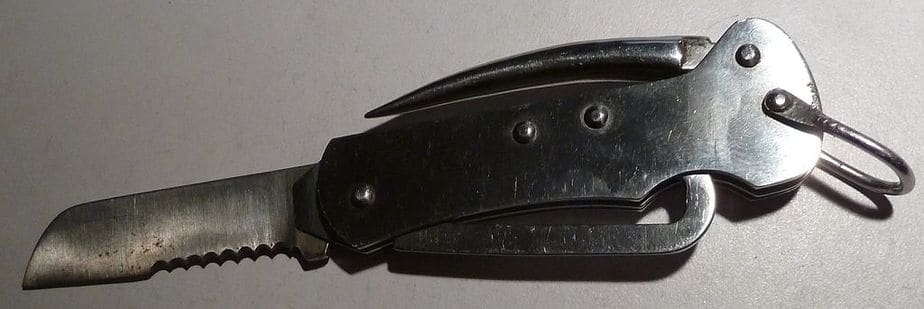Even though snorkeling is an activity with a low barrier of entry, unlike scuba diving, many inexperienced snorkelers spend a lot of time and energy flailing about, struggling to stay afloat instead of enjoying the underwater views.
The truth is, many beginners just want to casually stay afloat and would benefit greatly by using a snorkel flotation device. Whether you are still getting used to snorkeling or you just want to relax and remain buoyant effortlessly, a flotation belt for snorkeling could be the solution.
Our Top Picks:
What is a Snorkeling Flotation Belt?
A flotation belt is just one type of flotation device that can assist snorkelers (and swimmers) by keeping them afloat without limiting their movements. It is worn like a regular belt and held in place with a buckle or clip. In addition to being used by beginner snorkelers, they are also a great tool to assist older snorkelers. Flotation belts can also help people with physical disabilities stay buoyant when swimming.
Recommended Flotation Belts for Snorkeling
AquaJogger Pro Plus Belt
- Aqua Jogger is the leader in aquatics exercise
- Suspends body vertically in water
- Quality construction and very durable
If a muscular or lean physique is making it hard to stay afloat, then the AquaJogger Pro Plus is the optimal solution. Though this belt is typically marketed to men, it can be used by people of either gender that require assistance in the water. It is extremely buoyant thanks to its thick foam. With a closed-cell foam design that is two inches thick, some users may find it awkward to use, but at least you won’t be sinking anytime soon.
The AquaJogger Pro Plus features a high-back cut, which means it will gently tip you forward, keeping you facing toward the water. For snorkelers, this is ideal as you want to be looking downwards anyways. However, those who want to remain upright should steer clear from this product, as you will be constantly fighting against it. For those users, we recommend looking for a belt that distributes weight more evenly around the body. Otherwise, the AquaJogger Pro Plus is great for leaner or more muscular individuals.
Features:
- Extremely buoyant, perfect for those with lean or muscular physiques who are less buoyant.
- 2” thick closed-cell foam.
- Though it is marketed to men, women can use it as well.
WaterGym Water Aerobics Float Belt
- COMES IN 2 SIZES: Small & Med/Large. SIZE INFO below and SIZE CHART to left. This page listing is for size SMALL. M/L size also sold on Amazon on...
- NEW ERGONOMIC TAPERED DESIGN: Ultimate comfort! Won't bruise, dig, pinch or tip you forward. New from manufacturer with IMPORTANT fitting...
- SOFT FOAM: Unique custom molded, high quality, smooth foam feels soft and silky. Won't rub or chafe. Solid throughout. No coatings!
Snorkel in ultimate comfort with the WaterGym Float Belt, designed so that it won’t bruise or rub against your body. The soft foam is custom molded and will easily conform to your body. Soon after you put it on, you’ll hardly even remember it’s there because of how soft and silky the foam is. Furthermore, the foam is slightly tapered on each end, and the belt buckle fastens effortlessly.
Make sure it is tightly fastened so that it won’t ride up on you in the water. There are three sizes to choose from, so be sure to read the product description carefully to ensure you have the right size. For those who want a belt that provides significant buoyancy, this belt probably isn’t for you.
Features:
- Custom-molded foam that is extremely comfortable.
- Will not bruise or rub against your body, or ride up your armpits.
- Multiple sizes to choose from.
Hydro-Fit Classic Wave Belt
- The Classic WAVE Belt is made of soft and durable EVA foam for even buoyancy during water workouts.
- With a unique contour shape, the belt fits your body and enhances correct posture and body alignment.
- The quick-release buckle strap ensures a secure fit, so you can spend more time working out and less time adjusting your belt.
The Hydro-Fit Wave Belt has been in use for decades, and for good reason. Even though it is great for many users, we feel that it is especially beneficial for seniors due because it can be threaded with a velcro strap as a fastener instead of a buckle. Seniors or physically disabled individuals may have trouble using a buckle, and a hook-and-latch design is easier on their bodies.
Furthermore, the Wave’s tapered design will help you remain vertical with no effort on your part. Also, you’ll not find it riding up your torso and into your armpits. Many customers agree that the Wave belt is much better at this than its competitors. The Hydro-Fit Wave will eventually conform to your body shape for an even better fit after subsequent uses. And of course, you can expect that the Hydro-Fit Wave is made from high-quality EVA foam.
Features:
- Velcro strap instead of a buckle makes this an ideal choice for seniors, the physically disabled, or people with arthritis.
- Will not ride up your armpits.
- Tapered foam design helps you remain vertical.
- Conforms to your body.
Water Gear Instructional Swim Belt
- Floatation for swim training or aqua aerobics
- Soft, comfortable closed cell EVA foam
- Will not chip, break or absorb water
For those wanting to improve their swimming and snorkeling skills, look no further the Water Gear Instructional Swim Belt. There are both youth and adult versions available at a great price point. The youth version has four 5” x 5” foam blocks connected to a lightweight strap. The adult version has a thicker strap, with five foam pads.
Each foam module can be adjusted along the strap so that it can fit your body shape comfortably. Additionally, you can remove some squares to adjust your buoyancy or to challenge yourself. Personally, we love the modular design because it makes packing it up for storage or travel so much easier. You can also lend it to other family members and add or remove the foam modules as needed for the optimal fit.
For those looking to get into snorkeling or want to improve their swimming ability, the Water Gear Instructional Swim Belt is an excellent starting point to assist you.
Features:
- Versatile foam modules that can be adjusted along the strap, or even removed to reduce buoyancy as needed.
- Youth and adult versions; the adult version can simply have some blocks removed and worn by a child as a hand-me-down.
- Great price point, and a good way to get comfortable with swimming and snorkeling.
What to Look for In a Flotation Belt for Snorkeling
If you want to find the best flotation belt for snorkeling, there are some criteria that you should keep in mind to get the best bang for your buck. With so many on the market, you should carefully consider the brand, design, material, size, weight rating, and fit.
Size
You want a belt that fits comfortably around your waist. This shouldn’t be too difficult, as belts can be adjusted so that they fit without being too tight or loose. Keep in mind that it may be slightly uncomfortable the first time you wear one. However, once you break it in and get used to it, you’ll hardly even notice it’s there. Furthermore, most belts have a size chart that you can reference to determine the correct waist sizes each belt is made for.
Material
The most common belts are essentially a nylon belt with EVA, or “closed-cell” foam attached to it. The foam may also be dipped in vinyl, is unaffected by exposure to chlorine, and does not absorb water. The vinyl coating should make the foam glide off your skin; otherwise, it could rub painfully against your skin or cause rashes.
Other belts use an elastic material which also feels more comfortable to wear. Lastly, there are belts made of inflatable polyester, but they do not offer as much support in the water and are not very popular as a result.
Design
There are three common types of flotation belts for snorkeling. The first style is foam blocks attached to a belt as we discussed above. The next belt is essentially a long rectangular foam block with the ends attached to a belt fastener. This is the same kind of buoyancy belt that water-skiers use, and it can also double as a snorkeling belt.
The third design is a molded foam that secures firmly against your lower back and chest. This design is the best option for large individuals that require more buoyancy while snorkeling.
Brand
Unfortunately, this is probably the criteria where you’ll have the least flexibility. Though there are numerous brands on the market, they don’t necessarily provide the quality you deserve. We recommend sticking to reputable brands, especially ones that specialize in flotation devices such as snorkeling belts. They will be more reliable, have a manufacturer’s warranty, and will have more reliable customer feedback to take into account.
Weight Rating
All belts have a limit to how much weight they can support. Adult flotation belts are universal, so their maximum body weight rating should be nearly identical. However, children’s flotation belts tend to have different ratings. Before purchasing a belt, you must figure out how much weight it can support so that you (or whoever will wear it) can stay safe and afloat in the water.
In addition, the amount of buoyancy you want depends on how you plan to use the belt. For instance, people doing water aerobics should look for a belt that will give them more vertical lift. In this case, for snorkeling, you don’t exactly want to be rising high above the water.
As such, look for a flotation belt that can still keep your head above water, but prevent your midsection from being completely out of the water. This allows you to enjoy the views underwater without feeling like you’re going to sink.
To do so, one recommendation is to look for a snorkel flotation belt that has adjustable or removable sections of foam. That way, you have more options to increase or decrease the buoyancy to the optimal level. Women would benefit from this as well, since they are typically lighter than men and may want to decrease the buoyancy of the belt.
Fit
Typically, the standard sizes are small, medium, and large. For people in between sizes, you can adjust the strap for a better fit. For children the discrepancy between sizes will be large, and so you should carefully check the measurements to ensure it’s not too big or small for your child. Also consider whether removing any of the foam blocks would affect how the belt fits you.
Versatility
Even though the topic of this article is specifically about snorkeling flotation belts, we would be remiss to not mention the multiple applications any flotation device can be used for. If you want to try your hand at other sports, such as water-skiing, water running, aerobics, or just improving your swimming strength, you can use the belt to assist you.
Frequently Asked Questions
Is A Flotation Belt Required to Snorkel?
No, most people need it, but don’t feel bad if you wish to use one. The point of the float belt is not only to provide safety, but also instill confidence in someone who is not a strong swimmer. Furthermore, if you plan on snorkeling for extended periods of time, even strong swimmers will eventually fatigue, so there is no shame in getting one. Older snorkelers or people with physical disabilities will still be able to snorkel if they wear a flotation device.
Is A Snorkeling Belt A Life Saving Device?
As useful as they are, snorkeling belts are not considered life-saving personal flotation devices and are not approved by the United States Coast Guard or other authorities as such. While they can keep you afloat, they are not rated to float a distressed or unconscious person in such a way that their face remains out of the water. To be safe, only go into the water with at least one partner or a group, and children should be kept under constant supervision.
Can You Snorkel Longer with a Float Belt?
Without using a snorkeling belt, snorkelers will need to spend energy just to stay afloat. That energy could have been better spent actually exploring the ocean or moving to a different location with better sights. With a flotation belt, snorkelers can more easily remain buoyant in a vertical position. With the energy they save, they can even venture further than before for even more adventures.
How Does a Float Belt Compare to a Snorkel Vest?
Though some snorkeling and swimming enthusiasts believe that float belts are the superior option, there are some who say otherwise. They argue that when snorkel vests are worn on top of a wetsuit, it doesn’t cause any drag at all. With that said, those who prefer float belts say they hardly notice it’s even there as well. At the end of the day, it seems like it’s just based on personal preference, so at some point you should try both to see which one you favor.
What Are the Advantages of a Float Belt?
For how affordable they are, float belts provide enough benefits that they easily justify their cost. And if you take good care of them, they can last you for years before needing a replacement. Maintenance is as simple as rinsing the belt with water after each swim, allowing it to fully dry, and then storing it until the next time you need to use it. Furthermore, they are compact and should not take up too much space next to all of your other snorkeling gear.
We’ve already covered the safety benefits for beginner snorkelers as well as how a flotation belt can help you conserve energy. Furthermore, some belts provide additional support to your torso, helping your spine remain straight in the water. This, in turn, can prevent any back pain caused by poor posture or maintaining an unnatural curvature of the spine for long periods of time.
Are Float Belts Safe for Children?
Yes, in fact, there are flotation belts designed specifically for children. If your child is not confident in their swimming skill, then the flotation belt can assist them in learning how to swim and snorkel. Once they are confident they are confident they can stay afloat on their own, then they can retire the belt.
With that said, float belts can also give parents peace of mind that their child has extra protection in the water. Furthermore, float belts don’t give parents license to leave their child unsupervised; they should only be used as back-up.
There are other flotation devices that children can use, such as a snorkel vest, which also provides excellent protection and comfort. The advantage of a snorkel vest is that they are easier to swim with.
Are Float Belts Only Meant for Beginners?
No, anybody can use a float belt for any reason. For instance, even professionals can use them. Sometimes, people just want to relax, even if they are expert level swimmers. Thus, float belts lets them do some “lazy” snorkeling, where they do not have any time limit and can remain in the water for as long as they want. With that said, if you are a beginner snorkeler, you can check out this article for some tips.
What Are Some Alternatives to Float Belts?
There are other snorkeling flotation devices that you can choose from. We’ve already mentioned the snorkel vest. You can also get a traditional life jacket, as well as a pool noodle.
A life jacket is a reliable flotation device, however the reason we generally do not recommend it is that they are bulky and hard to swim with. They should be used in situations where there is fast moving water, and are somewhat of a hindrance for someone that just wants to leisurely snorkel in shallow, calm waters.
A pool noodle should just be used as a practice tool in the swimming pool. As part of your research, you can try using a pool noodle to get a feel for how effective flotation devices are. With that said, in the ocean there is always a chance that a pool noodle can slip out from under you, and should not be relied upon. At that point, you should consider getting either a snorkel vest or buoyancy belt.
One fact that people neglect to mention is that wetsuits for snorkeling, especially the thicker ones, actually help you float. This is because there are air bubbles trapped in the neoprene material in a wetsuit, meaning you will stay afloat much easier just by wearing the suit.
What Are the Differences Between a Snorkeling and Swimming Belt?
With all of the buoyancy belts on the market, it can be quite confusing as to the exact purpose of each one. Both the snorkeling belt and swimming belt serve different purposes.
A swimming belt is intended to increase the swimmer’s endurance, strength, and performance. It essentially adds resistance to the swimmer’s body, making them exert themselves harder so that they can improve.
On the other hand, a snorkeling belt’s purpose is to keep you afloat by providing resistance to sinking, while simultaneously trying not to restrict movement in any way.
But wait, there’s more! Neither of these belts should be confused with a freediving or scuba diving belt, as they provide a level of negative buoyancy so that divers can remain neutrally buoyant (neither sinking or rising) underwater. If you need a belt for snorkeling, don’t get the wrong one!
Flotation Belt Care Guide
If you are an avid snorkeler, you will be subjecting your flotation belt through strenuous use. For those of you who don’t properly take care of it, you’ll find that it won’t last very long and you’ll have to keep replacing it. No matter how durable a belt is, proper maintenance is necessary to ensure that it keeps going as strong as you. Here are some tips to take better care of your flotation belt.
Rinse After Use
Even though snorkel flotation belts are constructed from durable materials that don’t absorb water and are resistant to chlorine, constant exposure to salt and chlorine water will eventually wear down all types of flotation devices. As such, you should rinse it off with freshwater immediately after each use.
Whether you just finished swimming in the pool or in the ocean, make sure to give it a good rinse. You don’t need any fancy detergent, just a few seconds of running it under freshwater should be sufficient. In addition to getting rid of salt and chlorine, you’ll also get rid of the smell.
Air Dry
After rinsing, you need to make sure the belt dries properly. Storing it when it’s soaking wet will lead to mold growth which, when inhaled, is damaging to your lungs and is generally unpleasant to deal with. If you’re heading back home in your car, just towel dry it first before putting it in your bag and once you’re home leave it out to air dry. If you have a home pool, just leave it in a dark, well-ventilated room to dry.
Some dry bags have mesh pockets that you can store your wet snorkeling belt in so that it can air dry even as you are on the move. This is perfect if you are snorkeling away from home since you don’t have to wait around for it to dry.
You may be tempted to leave your flotation belt in the sun to dry. Don’t leave anything in direct sunlight because the UV rays can crack and damage the material, compromising its effectiveness.
Beware of Children
Young children are curious and may see a flotation belt as just another toy they can thrash around. Depending on the age of your kids, you might want to consider putting the belt in a place that only adults can access. Though it may sometimes seem like it, children often mean no harm but they can still cause a lot of damage to expensive gear.
They’ll throw it, tear it, twist it, bend it, or even bite at the foamy material. Once again, no matter how durable the materials are, this level of wear and tear will quickly ruin a belt unless you can rein your children in.
Store Separately
The last tip to keep your snorkel belt feeling and looking like the day that you bought it is how to store it. Soft, foamy material should be stored flat and separately from other snorkeling equipment. Your other gear, specifically the fins and snorkel can prod and poke at a flotation belt, causing it to dent and tear. By storing the belt separately, you can help keep it puncture free and flexible.
The Bottom Line
Float belts are an excellent way to stay buoyant while snorkeling. Anyone can use it, but it is especially helpful for beginners, older snorkelers, or people with physical disabilities. Even the average snorkeler can use it to conserve energy and extend how long they can stay in the water. Additionally, they are cheap, effective, and help you maintain good posture. Observe the underwater life without having to worry about staying afloat.
When shopping for the best flotation belt for snorkeling, you should consider the following criteria: materials, size, brand, fit, and any additional features that makes it stand out from the rest. You can buy them online, in store at a local dive shop, or can be rented if you are just vacationing. If you decide to buy one, make sure to rinse and dry after each use, and it will last you for many years.

